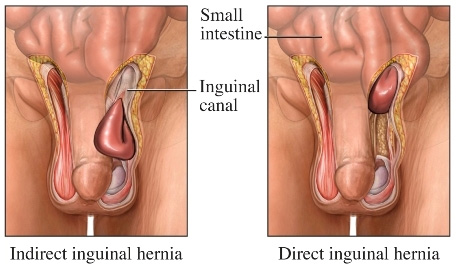

A groin hernia is an external bulge in the groin area that contains fat, connective tissue, and/or a portion of intestine. There are two main types:
Inguinal hernia-occurs when there is a weak spot in the area where the abdomen meets the thigh on both sides (most common type)
Femoral hernia-occurs less frequently, located in the upper thigh
A groin hernia that pushes through the abdominal wall can trap a section of intestine. This can lead to an emergency where the intestine is blocked or strangled.
A risk factor is something that increases your chance of getting a disease or condition. Risk factors include :
Advancing age
Sex: male (Groin hernias are about 10 times more common in men. Femoral hernias are more common in women.)
Vigorous physical activity such as occurs in sports like football and rugby
Increased pressure within the abdominal cavity due to:
Lifting heavy objects
Straining to urinate or pass stools
Severe or prolonged coughing
Obesity
Pregnancy
1. A bulge in the groin area when standing or straining
2. Pain in the groin area when straining
3. A bulge that may extend into the scrotum in men
4. Pain, a heavy feeling, or discomfort in the groin (Sometimes there is no pain.)
Severe pain in the groin or abdomen
Fever
Rapid heart beat
Abdominal swelling
Nausea
Vomiting
The doctor will ask about your symptoms and medical history, and perform a physical exam. In some cases, you may have a CT scan or ultrasound.
Most inguinal hernias require surgery. If it is a small hernia that can be pushed back into place, an external pad (called a truss) may be worn to provide support. Surgery is usually still needed at some point.
After surgery , hernias sometimes return, either on the same side or the opposite side. Hernia repair can cause pain and disrupt your quality of life, but these complications are rare.
Herniorrhaphy -to repair the defect in the abdominal wall
Hernioplasty-to reinforce the weak area with steel mesh or wire
Bowel resection -to remove a section of the intestine, may be used when part of the intestine becomes twisted or blocked or turns gangrenous and dies
Laparoscopic hernia repair-done through several tiny incisions in the groin or abdomen, recovery may be faster
